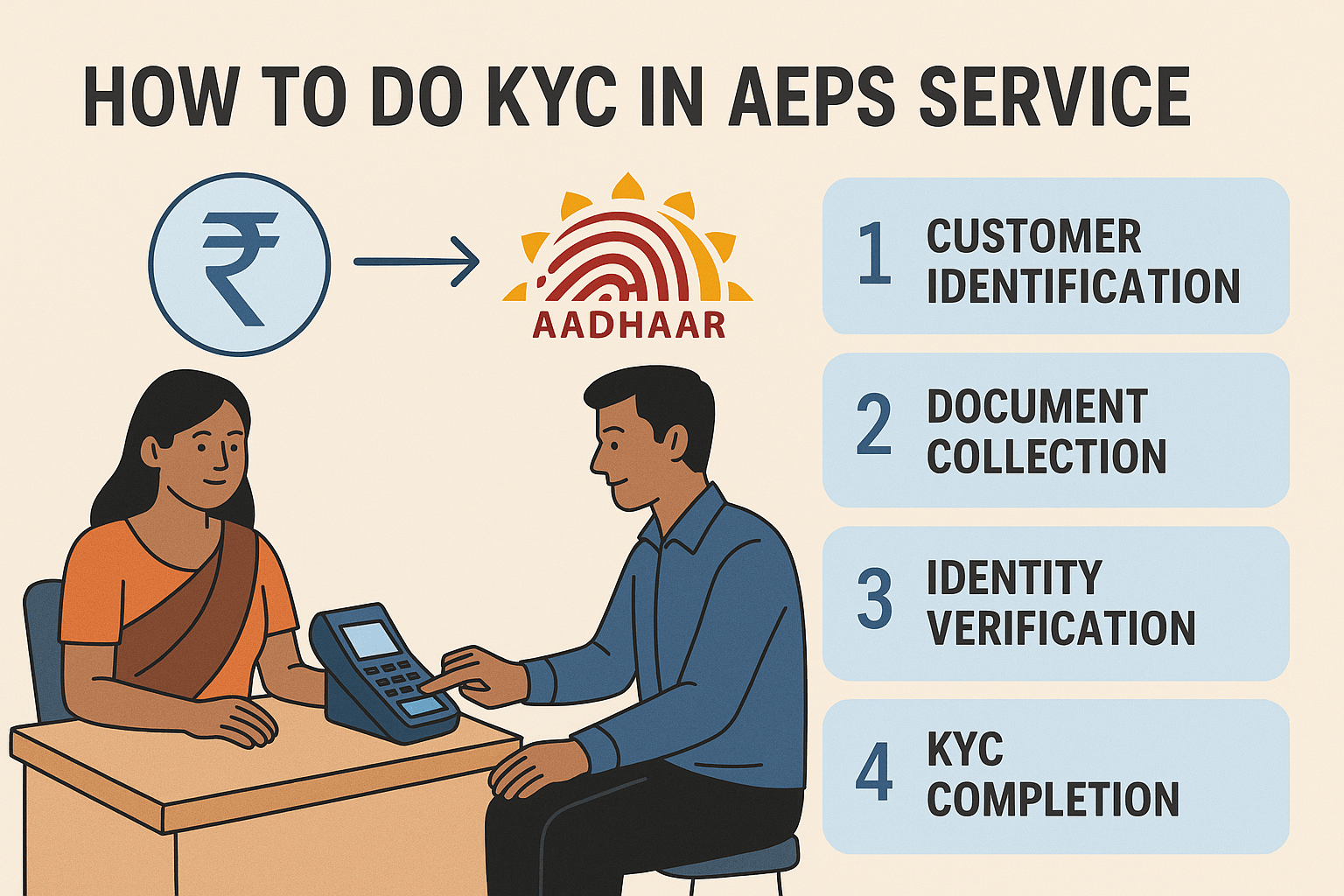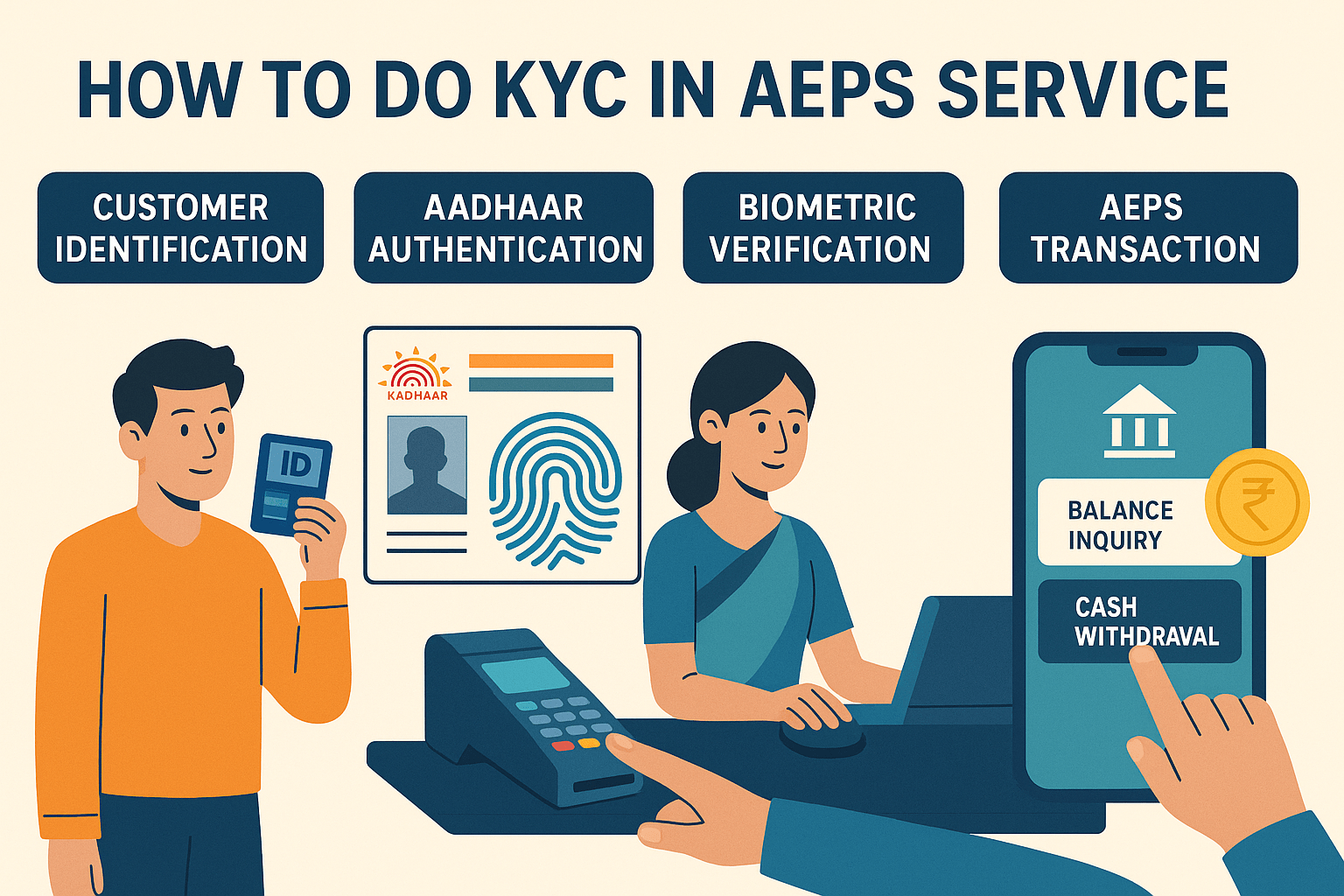In the rapidly digitizing landscape of Indian finance, the (KYC in AEPS service) Aadhaar Enabled Payment System (AEPS) stands as a revolutionary pillar, bringing banking services to the doorstep of millions. But for this system to function securely, a robust identity verification process is essential. This is where KYC in AEPS service plays its critical role. If you’ve ever wondered how a simple fingerprint can authorize a cash withdrawal or balance inquiry, you’re about to find out. This guide will walk you through the complete process, types, and importance of how to do KYC in AEPS service.
What Exactly are AEPS and KYC?
Before we dive into the process, let’s quickly demystify the two acronyms.
-
AEPS (Aadhaar Enabled Payment System): Think of AEPS as a bridge. It’s a bank-led model that allows you to perform basic banking transactions—like cash withdrawal, deposit, fund transfer, and balance inquiry—at a MicroATM or through a Business Correspondent (BC) using only your Aadhaar number and biometric authentication (fingerprint/iris scan). No need for a physical card, PIN, or your phone.
-
KYC (Know Your Customer): This is the mandatory process regulated by the Reserve Bank of India (RBI) that financial institutions use to verify the identity and address of their clients. It’s a cornerstone for preventing fraud, money laundering, and other illicit financial activities.
Therefore, KYC in AEPS service is the fusion of these two concepts: it’s the method by which a bank uses your Aadhaar details to verify that you are indeed who you claim to be, enabling you to access AEPS services securely.

The Two Types of KYC in the Financial World
Understanding the broader KYC landscape helps contextualize the AEPS process. There are two primary types:
-
Aadhaar-based e-KYC (Electronic KYC): This is the heart of AEPS. It is a paperless, digital process that uses Aadhaar authentication via biometrics or OTP to fetch your demographic details (name, address, date of birth, gender) and photograph directly from the Unique Identification Authority of India (UIDAI) database. It’s instantaneous and highly secure.
-
Offline KYC: This is a more traditional method involving physical documents like a passport, voter ID, or driver’s license for identity proof, and utility bills for address proof. While still valid, it is not used for the real-time authentication required by AEPS transactions.
For AEPS, the Aadhaar-based e-KYC is the exclusive and enabling method.
The Step-by-Step Process: How to do KYC in AEPS Service
The beauty of AEPS KYC lies in its simplicity and efficiency. The process is largely the same for end-users, whether you’re at a banking kiosk in a metro or a village BC agent’s outlet.
Prerequisites for AEPS KYC:
-
Your 12-digit Aadhaar number.
-
Your bank account must be linked with your Aadhaar number. You can link it via your bank’s net banking portal, ATM, branch, or by giving a mandate to your BC agent.
-
Your biometric data (fingerprints/iris) must be updated and synced with the UIDAI database. If your fingerprints are worn out or not reading correctly, you must visit an Aadhaar enrolment centre to update them.
The On-Ground Transaction Flow:
Here’s how the KYC and transaction happen in real-time:
-
Initiation: You approach an AEPS service point—a BC agent with a MicroATM device. You inform them you wish to perform a transaction (e.g., withdraw cash).
-
Providing Details: The agent will ask for your:
-
Aadhaar Number (which you provide verbally or by letting them scan your Aadhaar card’s QR code).
-
Bank Name (or IIN – Bank Identification Number).
-
Transaction Type (e.g., cash withdrawal).
-
-
Biometric Authentication: This is the core of the KYC in AEPS service. You will be asked to place your finger on the biometric scanner connected to the MicroATM device.
-
The Digital Handshake: The MicroATM device encrypts your Aadhaar number and biometric data and sends this authentication request to the National Payments Corporation of India (NPCI) switch.
-
UIDAI Verification: The NPCI forwards the request to the UIDAI servers. UIDAI verifies whether the provided biometrics match the stored biometrics for that specific Aadhaar number. This is the actual KYC verification moment.
-
Authorization and Completion:
-
If the biometrics match, UIDAI sends a “Yes” confirmation back to the NPCI.
-
NPCI then routes the request to your respective bank.
-
Your bank, which already has your Aadhaar-linked account, verifies the details and approves the transaction.
-
The bank sends an approval message back through the NPCI to the MicroATM.
-
The MicroATM dispenses cash (if applicable) and prints a receipt as proof of the transaction.
-
This entire process, from placing your finger to getting cash, typically happens in less than 30 seconds. The KYC is not a separate step; it is the integral, real-time authentication that makes the transaction possible.
https://www.npci.org.in/sites/default/files/AEPS%2520Flow.png
Image Alt Text: How to do KYC in AEPS Service – Flowchart showing the process from customer to bank via BC, NPCI, and UIDAI.

Why is KYC for AEPS So Important?
The integration of KYC in AEPS service is not just a regulatory hoop to jump through. It serves multiple critical purposes:
-
Financial Inclusion: It allows millions of Indians in rural and remote areas, who may lack traditional identity documents, to access formal banking services using the one document nearly everyone has: Aadhaar.
-
Fraud Prevention: Biometric authentication is extremely difficult to forge. It ensures that only the legitimate account holder can authorize a transaction, drastically reducing the risk of identity theft and fraud.
-
Security & Privacy: Your biometric data never leaves the UIDAI servers. The authentication process only confirms a “Yes” or “No” match without sharing or storing your biometrics on the MicroATM or the bank’s server.
-
Convenience: It eliminates the need to remember PINs, carry physical cards, or fill out lengthy paperwork for every small transaction.
The Future of AEPS and KYC
The ecosystem is evolving. The introduction of Aadhaar Fingerprint Authentication for APB (Aadhaar Payment Bridge) and AePS 2.0 promises enhanced security features, including encrypted biometric data and a more robust infrastructure. The core principle, however, will remain the same: using Aadhaar as the foundational identity for seamless and secure KYC in AEPS service.
Conclusion
Understanding how to do KYC in AEPS service reveals the elegant simplicity and powerful security behind a technology that has transformed financial inclusion in India. It’s a process that turns your unique identity—your fingerprint—into the key to your bank account, enabling secure, convenient, and instantaneous transactions without any physical intermediaries. The next time you use an AEPS service, you’ll appreciate the sophisticated digital handshake between your fingerprint, UIDAI, NPCI, and your bank that makes it all possible.
Frequently Asked Questions (FAQs)
1. Is it mandatory to link my Aadhaar to my bank account for AEPS?
Yes, it is absolutely mandatory. Your bank account must be seeded (linked) with your Aadhaar number for the UIDAI authentication to be successfully routed to your specific account for transaction processing.
2. What if my fingerprint is not being recognized?
This is a common issue, especially for people with worn-out fingerprints due to manual labor. You must visit the nearest Aadhaar Enrolment/Update Centre to update your biometrics in the UIDAI database. You can also use iris authentication if the MicroATM device supports it.
3. Is AEPS KYC safe? Can someone misuse my Aadhaar number?
The system is designed with security in mind. Your biometric data is not stored on any device except the UIDAI servers. A transaction cannot be completed without your biometrics. However, you should still be cautious and only provide your Aadhaar number to authorized and trusted BC agents.
4. Can I do AEPS KYC from my home?
The typical AEPS transaction requiring biometrics needs a physical MicroATM device. However, some banks offer AEPS-based services through their BC agents who can visit your home. For purely digital KYC (like opening an account), many banks and payment wallets use Aadhaar OTP-based e-KYC, which can be done from a smartphone.
5. Are there any charges for doing KYC or using AEPS?
The KYC authentication itself does not have a direct charge for the customer. However, banks may levy nominal transaction charges for AEPS services (e.g., a small fee for cash withdrawal), though many transactions are kept free to promote digital payments.
Disclaimer: This article is for educational and informational purposes only. The specific processes, regulations, and technologies surrounding AEPS and KYC are subject to change as per guidelines from the Reserve Bank of India (RBI), National Payments Corporation of India (NPCI), and UIDAI. Readers are advised to consult directly with their banks or official resources for the most current information. If you have any concerns regarding the content of this post, please visit our DMCA page to review our policy and guide for content removal requests.
